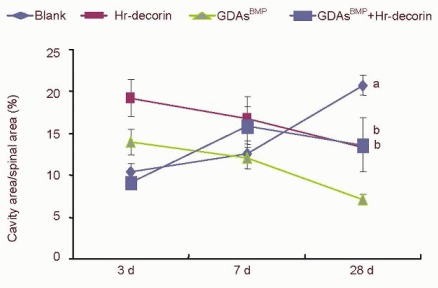Figure 5.

Effect of combined GDAsBMP and hr-decorin transplantation on the ratio between the cavity and cross-sectional areas in the contusive spinal cord of rats.
The cavity and cross-sectional areas of spinal cord in the glial fibrillary acidic protein-positive astrocyte fluorescence image were measured and analyzed with Image Pro Plus 6.0 software, and calculated by pixels. The ratio between the cavity area and cross-sectional area of the blank group gradually increased to the maximum compared with the treatment groups at 28 days after spinal cord contusion (aP < 0.05), while the hr-decorin treatment group and the GDAsBMP transplantation group slowly decreased. The combined GDAsBMP and hr-decorin transplantation group increased and then decreased compared with the blank and the GDAsBMP transplantation groups at 28 days after spinal cord contusion (bP < 0.05). Data are expressed as mean ± SD of six rats for each group (two-sample t-test and one-way analysis of variance).
Blank: Spinal cord injury group; Hr-decorin: human recombinant decorin injection group; GDAsBMP: glial-restricted precursor-derived astrocytes induced by bone morphogenetic protein-4 transplantation group; GDAsBMP + Hr-decorin: combined GDAsBMP and hr-decorin transplantation group.
